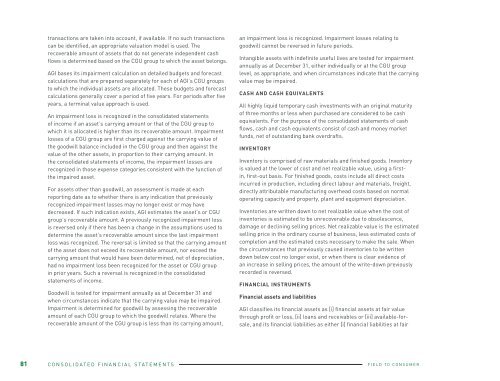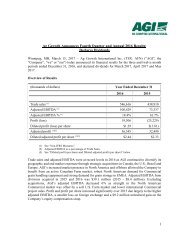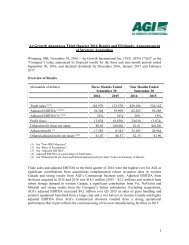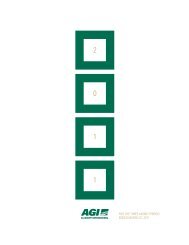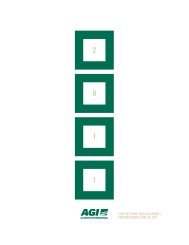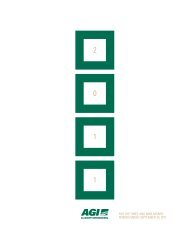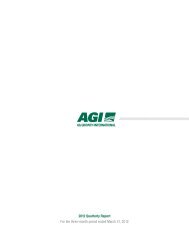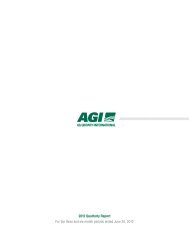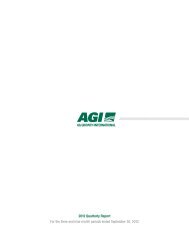2016 Annual Report For Web 7.3MB
Create successful ePaper yourself
Turn your PDF publications into a flip-book with our unique Google optimized e-Paper software.
transactions are taken into account, if available. If no such transactions<br />
can be identified, an appropriate valuation model is used. The<br />
recoverable amount of assets that do not generate independent cash<br />
flows is determined based on the CGU group to which the asset belongs.<br />
AGI bases its impairment calculation on detailed budgets and forecast<br />
calculations that are prepared separately for each of AGI’s CGU groups<br />
to which the individual assets are allocated. These budgets and forecast<br />
calculations generally cover a period of five years. <strong>For</strong> periods after five<br />
years, a terminal value approach is used.<br />
An impairment loss is recognized in the consolidated statements<br />
of income if an asset’s carrying amount or that of the CGU group to<br />
which it is allocated is higher than its recoverable amount. Impairment<br />
losses of a CGU group are first charged against the carrying value of<br />
the goodwill balance included in the CGU group and then against the<br />
value of the other assets, in proportion to their carrying amount. In<br />
the consolidated statements of income, the impairment losses are<br />
recognized in those expense categories consistent with the function of<br />
the impaired asset.<br />
<strong>For</strong> assets other than goodwill, an assessment is made at each<br />
reporting date as to whether there is any indication that previously<br />
recognized impairment losses may no longer exist or may have<br />
decreased. If such indication exists, AGI estimates the asset’s or CGU<br />
group’s recoverable amount. A previously recognized impairment loss<br />
is reversed only if there has been a change in the assumptions used to<br />
determine the asset’s recoverable amount since the last impairment<br />
loss was recognized. The reversal is limited so that the carrying amount<br />
of the asset does not exceed its recoverable amount, nor exceed the<br />
carrying amount that would have been determined, net of depreciation,<br />
had no impairment loss been recognized for the asset or CGU group<br />
in prior years. Such a reversal is recognized in the consolidated<br />
statements of income.<br />
Goodwill is tested for impairment annually as at December 31 and<br />
when circumstances indicate that the carrying value may be impaired.<br />
Impairment is determined for goodwill by assessing the recoverable<br />
amount of each CGU group to which the goodwill relates. Where the<br />
recoverable amount of the CGU group is less than its carrying amount,<br />
an impairment loss is recognized. Impairment losses relating to<br />
goodwill cannot be reversed in future periods.<br />
Intangible assets with indefinite useful lives are tested for impairment<br />
annually as at December 31, either individually or at the CGU group<br />
level, as appropriate, and when circumstances indicate that the carrying<br />
value may be impaired.<br />
CASH AND CASH EQUIVALENTS<br />
All highly liquid temporary cash investments with an original maturity<br />
of three months or less when purchased are considered to be cash<br />
equivalents. <strong>For</strong> the purpose of the consolidated statements of cash<br />
flows, cash and cash equivalents consist of cash and money market<br />
funds, net of outstanding bank overdrafts.<br />
INVENTORY<br />
Inventory is comprised of raw materials and finished goods. Inventory<br />
is valued at the lower of cost and net realizable value, using a firstin,<br />
first-out basis. <strong>For</strong> finished goods, costs include all direct costs<br />
incurred in production, including direct labour and materials, freight,<br />
directly attributable manufacturing overhead costs based on normal<br />
operating capacity and property, plant and equipment depreciation.<br />
Inventories are written down to net realizable value when the cost of<br />
inventories is estimated to be unrecoverable due to obsolescence,<br />
damage or declining selling prices. Net realizable value is the estimated<br />
selling price in the ordinary course of business, less estimated costs of<br />
completion and the estimated costs necessary to make the sale. When<br />
the circumstances that previously caused inventories to be written<br />
down below cost no longer exist, or when there is clear evidence of<br />
an increase in selling prices, the amount of the write-down previously<br />
recorded is reversed.<br />
FINANCIAL INSTRUMENTS<br />
Financial assets and liabilities<br />
AGI classifies its financial assets as [i] financial assets at fair value<br />
through profit or loss, [ii] loans and receivables or [iii] available-forsale,<br />
and its financial liabilities as either [i] financial liabilities at fair<br />
value through profit or loss [“FVTPL”] or [ii] other financial liabilities.<br />
Derivatives are designated as hedging instruments in an effective<br />
hedge, as appropriate. Appropriate classification of financial assets<br />
and liabilities is determined at the time of initial recognition or when<br />
reclassified in the consolidated statements of financial position.<br />
All financial instruments are recognized initially at fair value plus, in<br />
the case of investments and liabilities not at fair value through profit or<br />
loss, directly attributable transaction costs. Financial instruments are<br />
recognized on the trade date, which is the date on which AGI commits to<br />
purchase or sell the asset.<br />
Financial assets at fair value through profit or loss<br />
Financial assets at FVTPL include financial assets classified as heldfor-trading<br />
and financial assets designated upon initial recognition<br />
at FVTPL. Financial assets are classified as held-for-trading if they<br />
are acquired for the purpose of selling or repurchasing in the near<br />
term. This category includes cash and cash equivalents and derivative<br />
financial instruments entered into that are not designated as hedging<br />
instruments in hedge relationships as defined by IAS 39.<br />
Financial assets at FVTPL are carried in the consolidated statements of<br />
financial position at fair value with changes in the fair value recognized<br />
in finance income or finance costs in the consolidated statements of<br />
income.<br />
AGI has currently not designated any financial assets upon initial<br />
recognition as FVTPL.<br />
Derivatives embedded in host contracts are accounted for as separate<br />
derivatives and recorded at fair value if their economic characteristics<br />
and risks are not closely related to those of the host contracts and the<br />
host contracts are not held-for-trading. These embedded derivatives<br />
are measured at fair value with changes in fair value recognized in the<br />
consolidated statements of income. Reassessment only occurs if there<br />
is a change in the terms of the contract that significantly modifies the<br />
cash flows that would otherwise be required.<br />
Loans and receivables<br />
Loans and receivables are non-derivative financial assets with fixed or<br />
determinable payments that are not quoted in an active market. Assets<br />
in this category include receivables. Loans and receivables are initially<br />
recognized at fair value plus transaction costs. They are subsequently<br />
measured at amortized cost using the effective interest method less any<br />
impairment. The effective interest amortization is included in finance<br />
income in the consolidated statements of income. The losses arising<br />
from impairment are recognized in the consolidated statements of<br />
income in finance costs.<br />
Available-for-sale financial investments<br />
Available-for-sale financial investments include equity and debt<br />
securities. Equity investments classified as available-for-sale are<br />
those which are neither classified as held-for-trading nor designated<br />
at FVTPL. Debt securities in this category are those which are intended<br />
to be held for an indefinite period of time and which may be sold in<br />
response to needs for liquidity or in response to changes in the market<br />
conditions.<br />
After initial measurement, available-for-sale financial investments<br />
are subsequently measured at fair value with unrealized gains or<br />
losses recognized as other comprehensive income in the availablefor-sale<br />
reserve until the investment is derecognized, at which time<br />
the cumulative gain or loss is recognized in other operating income,<br />
or determined to be impaired, at which time the cumulative loss is<br />
reclassified to the consolidated statements of income and removed<br />
from the available-for-sale reserve.<br />
<strong>For</strong> a financial asset reclassified out of the available-for-sale category,<br />
any previous gain or loss on that asset that has been recognized in<br />
equity is amortized to profit or loss over the remaining life of the<br />
investment using the effective interest method. Any difference between<br />
the new amortized cost and the expected cash flows is also amortized<br />
over the remaining life of the asset using the effective interest method.<br />
If the asset is subsequently determined to be impaired, then the amount<br />
recorded in equity is reclassified to the consolidated statements of<br />
income.<br />
81 CONSOLIDATED FINANCIAL STATEMENTS<br />
FIELD TO CONSUMER<br />
<strong>2016</strong> ANNUAL REPORT<br />
CONSOLIDATED FINANCIAL STATEMENTS 82


